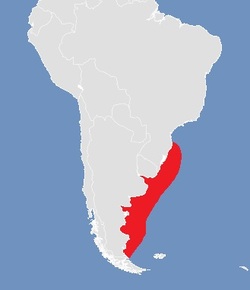
Common Name
Broadnose Sevengill Shark
Year Described
Peron, 1807
Identification
An elongate shark with a blunt snout, broad head, and large mouth. Dorsal fin placed far back on the body anterior to the anal fin base. Anal fin is smaller than the dorsal fin. The pelvic fins are slightly larger than both the dorsal and anal fins. Caudal fin is large with a well developed ventral lobe and sub-terminal notch. Caudal peduncle is short. There are seven long gill slits; the last ends anterior to the pectoral fin origin. The mouth extends past the posterior margin of the eye. The upper jaw has small yet sharp teeth and the lower jaw contains long, comb-shaped teeth in six rows. The eyes are small.
Color
Body is silvery-gray to brownish with a lighter belly. There are numerous dark blotches and black and white spots over the entire body. Young fish have white trailing edges on their median fins and a dark stripe on the caudal fin.
Size
Mature adults from 130-200 cm. Maximum size 300 cm or larger. Males mature at a smaller size than females.
Habitat
Ranges from estuarine, coastal waters to deep offshore waters to 136m. Younger sharks tend to live in shallower waters. Tends to remain close to the bottom but will venture to the surface at times. It is most active at night or in dark, turbid waters. It is an active predator that feeds on fishes, other sharks, rays, and marine mammals. It also eats carrion on occasion. Ovoviviparous (67-104 young). Females breed once every two years. May be migratory in its temperate range.
Range Map

Range
In the Atlantic found only along the coast of S. Brazil, Uruguay, and Argentina. The southern limit of its distribution is unclear.
References
Castro, J.I. 2011. The Sharks of North America. Oxford University Press, 640 pp.
Compagno, L., M. Dando, and S. Fowler. 2005. Sharks of the World. Princeton University Press, 480 pp.